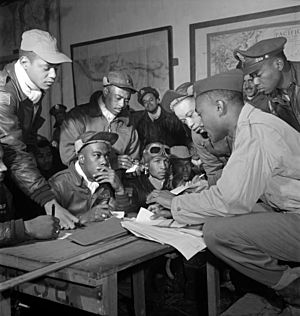Hiram Mann facts for kids
Hiram Mann (May 23, 1921 – May 17, 2014) was an American pilot and a retired lieutenant colonel in the United States Air Force. He was a brave member of the Tuskegee Airmen's 332nd Fighter Group. This was a special group of African-American pilots during World War II.
Mann flew 48 missions over Europe during the war. He was part of the "Red Tails," a nickname for the Tuskegee Airmen. They were called this because their P-51D Mustang planes had bright crimson red tails. The name "Tuskegee Airmen" became popular later, in 1972. Hiram Mann even named his own fighter plane "The Iron Lady" after his wife.
Early Life and Dreams
Hiram Mann was born in New York City on May 23, 1921. His parents had moved there from Alabama to find better chances. When he was very young, his family moved to Cleveland, Ohio. There, he went to schools where all races studied together.
As a child, Hiram dreamed of flying. He often built model airplanes from balsa wood. He once said he never thought he would actually get to fly a real plane.
After high school, Mann worked as a bellhop at the Hotel Cleveland. He later took a job at a factory that made steel and wire. This kind of work was important for the war effort. He also went to college for a year. While there, he met and married Kathadaza "Kitty" Mann in 1940.
Becoming a Red Tail Pilot
Even while working as a bellman, Hiram Mann really wanted to fly for the United States in World War II. But he faced many challenges. These included his race, being married, and his level of education.
His first application to become a pilot was turned down because he was African American. He wrote to the U.S. War Department, but they said no again. They told him there were no places to train African Americans to fly. This made him very upset. He applied a second time, but was rejected because he was married and had only one year of college. The military preferred single men with more education.
However, the U.S. government soon began training African-American pilots at Sharpe Field in Alabama. Hiram Mann applied for a third time. On December 7, 1942, he got a letter saying his application was on file. Finally, in 1943, he was accepted into the pilot training program. This happened after he passed many mental and physical tests. His wife, Kitty, moved back with her parents and finished college. She became a high school teacher during the war.
Mann finished his flight training in June 1944. He earned his silver wings and became a "Red Tail," part of the famous Tuskegee Airmen. He flew 48 combat missions over Europe. He flew two P-51D Mustang planes. He named both of them "Boss Lady" and "The Iron Lady" after his wife. He even had to bail out of one plane after it was shot. He remembered seeing enemy bullets flying past him during missions.
Life After the War
After the war, Hiram Mann continued his career in the U.S. Air Force. He retired from the military as a lieutenant colonel in 1972. He used the G.I. Bill to finish his bachelor's degree and later earned a master's degree.
Hiram and Kitty Mann retired to Titusville, Florida, in 1974. Hiram Mann often shared his experiences as a Tuskegee Airman. He spoke at colleges and schools, encouraging young people to get an education and never give up.
In 2013, he was one of four Tuskegee veterans who rode in a Model A Ford in Orlando, Florida's Veterans Day Parade. He also attended the dedication of the Tuskegee Airmen monument at the Orlando Science Center in 2013. This was the first monument in the country dedicated to the Tuskegee Airmen. A message on the monument says, "Their example inspires future generations to reach to the skies and to realize that all things are possible."
Hiram Mann passed away in Titusville, Florida, on May 17, 2014, at 92 years old. His wife, Kitty, had passed away in 2012. He was survived by his son, Gene Mann, and three grandchildren.




